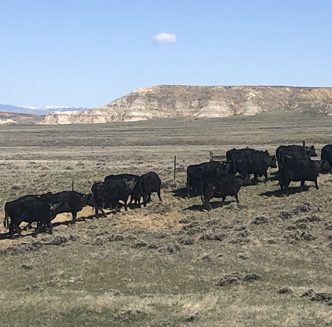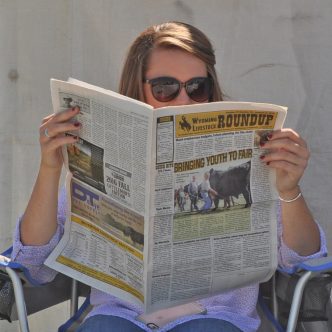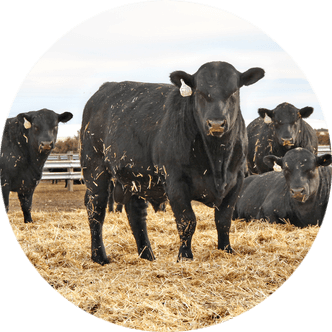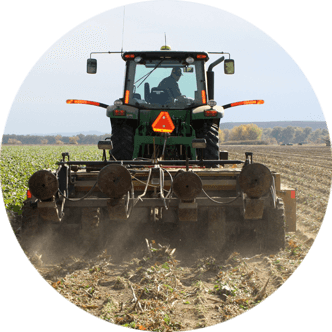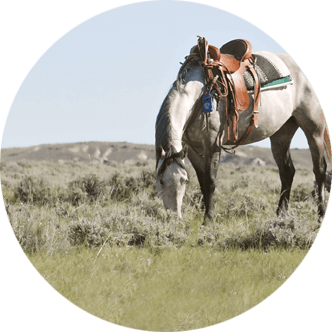Extension Education: Stretching Feed Resources in Wyoming: Practical Alternatives for Cow/Calf Producers
by By Makayla Getz
Wyoming ranchers know all too well the challenges of feeding their herd through long winters, dry summers and unpredictable hay supplies. When forage is short or feed costs climb, it’s time to think outside the bale.
Building an alternative feeding strategy can help maintain reproductive efficiency, support calf growth and keep input costs in check, all while using what’s locally available.
Begin with a strategy
A sound feeding program begins with clear goals, including keeping cows on track for rebreeding and calving on schedule; maintaining calf weight per cow and minimizing feed cost per pound of calf sold.
To meet these goals, consider the following Wyoming-adapted feeding principles.
Use what you’ve got. Maximize the use of local feeds – grass hay, millet, corn stalks, straw or whatever’s affordable and available.
Test and balance. Get a forage analysis and build rations to meet the cow’s nutritional needs – not more, not less.
Supplement wisely. Low-quality roughages like wheat straw or late-cut hay can work if paired with the right protein and energy sources.
Feed smart. High-need animals like lactating cows or growing heifers should get the best feeds.
Save lower-quality roughage for cows in mid-gestation.
Make the most of hay and grain
A good rule of thumb is one pound of grain can replace about two pounds of alfalfa or three pounds of grass hay.
Grain isn’t always easy to feed on pasture or rangeland, but Wyoming producers have found creative solutions – barrels, split pipe, old bunks and even feeders mounted on trailers.
For some, moving cows to a drylot during winter or drought can make it easier to feed limit-fed, high-energy rations. These grain-heavy diets reduce forage demand and lower feed costs, but they also require close management.
Limit intake, monitor condition and always provide at least 0.5 percent of body weight in roughage to support rumen health.
Transition cows slowly to high-grain diets over seven to 10 days. Start with two to three pounds of grain per head and free-choice hay, then increase grain and reduce hay gradually. Provide plenty of bunk space, feed twice a day if possible and keep a close eye on body condition.
Alternative feed options
In addition to hay and grain, a variety of byproducts and crop residues can supplement the Wyoming cow herd.
Corn stalks, millet hay, wheat straw and sorghum-sudan are often cheaper but need protein supplementation. Note, millet hay and sorghum-sudangrass may have nitrate issues under drought, so stop by a local Extension office and ask about testing forages.
Soybean hulls contain 10 to 16 percent protein, are a good source of energy and can be fed with or without hay.
Wheat middlings are high in both protein – at 18 percent – and energy.
Corn gluten feed are high in protein – at 25 percent – and great with a forage base.
Cottonseed hulls are low in protein but energy-dense, and should be paired with protein supplements.
Always provide a good mineral mix – especially calcium and phosphorus – and consider adding vitamin A during the winter or when feeding low-quality roughages.
Thinking outside the bale
During tough years, like the 2018 drought or COVID-era feed disruptions, producers have turned to unconventional feeds – distillers’ grains, cull potatoes and even sweet potatoes.
For example, “cow lasagna” is a popular way to stretch wet distillers’ grains. To do this, roll a cheap grass hay bale, layer on the wet grains, then repeat. Pack it down, cover it with plastic and let it ferment for 30-plus days. The result is a preserved, silage-style feed that lasts longer and reduces spoilage.
If feeding root crops like cull potatoes, process first to reduce choking risk, especially in competitive feeding settings. Monitor cows carefully when introducing new feeds or switching diets abruptly and always evaluate the nutritional and economic value of any alternative before committing.
The bottom line is Wyoming beef producers are no strangers to tough decisions, especially when it comes to feed. But with smart planning, local resources and flexible thinking, producers can keep cows productive even when the hay pile is running low.
Need help building a feeding plan or interpreting forage tests? Contact a local Extension office.
Makayla Getz is the UW Extension agriculture and natural resources educator serving Park County. She can be reached at 307-754-8836 or mgetz@uwyo.edu.

